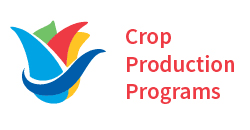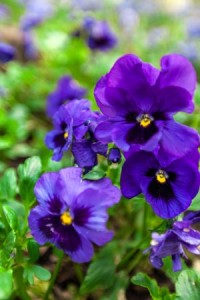
Pansy Fertilizer Tips & Programs
Different soilless mixes may be used for Pansy production, including mixtures of peat, perlite, rice hulls and composted pine bark. The media should provide good air space and be well drained. The starting pH should be adjusted between 5.7-6.2 for soilless mixes. Iron and Boron are two micro elements in high demand for optimal Pansy growth. These two micronutrients decrease in availablity when the pH rises above 5.8. pH during Pansy production should be maintained between 5.4-5.7 for soilless media and 5.6-6.0 for soil-based substrate.
EC levels should be maintained between 0.75-1.5 mS to promote good growth. Pansies are light feeders with a constant feed of 100 ppm N being suffiecient. In addition to their high demand for Iron and Boron, pansies also require 12.5-50 ppm of Magnesium, depending on their stage of growth.
Starting from seed, pansies should be fed with Plant-Prod 12-2-14 Optimum or Plant-Prod 14-0-14 Cal Mag. Both products have a 2:1 Ca:Mg ratio and higher levels of Molybdenum, Iron, and Magnesium.
Pansy fertilizer, as with all crops, is dependent upon the quality of the irrigation water being used. Options are available for various alkalinity levels. Acid injection (usually sulfuric acid) is used when the alkalinity level is above 250 ppm CaCO3 for growers who want a constant feeding program. MPPI can provide water tests to determine your alkalinity level and general water nutrient levels. Based on your water analysis, we can determine which fertilizer schedule would work for you.
For all water types, if extra Boron is required, as indicated from a soil test, drench the soil with 0.25 oz per 100 gallons of Solubor. Boron deficiency shows up as mottled younger growth and distorted leaves in severe situations. If acid is not an alternative, rotation between acidic blends and a Cal Mag is suggested. The fertilizer analysis suggested would be determined by the water sample results but in general the following guidelines apply:
Water alkalinity between 75-100 ppm CaCO3 with low Cal/Mg levels:
Use Plant-Prod® Solutions 17-5-17 Complete at 100 ppm N. Keep soil pH between 5.4-5.7.
Water alkalinity between 150-200 ppm CaCO3 with low Cal/Mg levels:
Option 1 – Use Plant-Prod Solutions 19-8-13 Total Plus at 100 ppm N.
Option 2 – Use Plant-Prod 20-8-20 All Purpose High Nitrate or Plant-Prod Solutions 19-2-19 Fertility Plus to provide extra Iron, Manganese, and Magnesium. Fertility Plus has a lower amount of Phosphorus which also helps to keep pansies compact. Continue to monitor Magnesium and Boron levels. When needed, supplement with Magnesium Nitrate and Solubor.
Water alkalinity greater than 250 ppm CaCO3:
Option 1 – Use acid as mentioned above. Use Plant-Prod Solutions 17-5-17 at 100 ppm N, alternated with Plant-Prod Solutions 19-8-13 Total Plus at 100 ppm N. Check pH of soil to keep pH between 5.4-5.7.
Option 2 – Use Plant-Prod Solutions 18-9-18 pH Reducer and alternate every 2nd or 3rd watering with Plant-Prod Solutions 19-8-13 Total Plus. Make sure you check your pH to keep it between 5.4-6.0. pH Reducer will decrease the pH in the soil and will also provide extra Iron, Manganese, Zinc and Boron.
Pansy Fertilizer should be reduced in the 2-3 weeks prior to shipping and Plant-Prod Solutions 15-0-20 No-Stretch® should be used to maintain compact but sturdy growth.

- Plant-Prod 12-2-14 Optimum Water Soluble Fertilizer
- Plant-Prod 14-0-14 Balance Water Soluble Fertilizer
- Plant-Prod 20-8-20 All Purpose High Nitrate Water Soluble Fertilizer
- Plant-Prod Solutions 15-0-20 No-Stretch® Water Soluble Fertilizer
- Plant-Prod Solutions 17-5-17 Complete Water Soluble Fertilizer
- Plant-Prod Solutions 18-9-18 pH Reducer Water Soluble Fertilizer
- Plant-Prod Solutions 19-8-13 Total Plus Water Soluble Fertilizer

